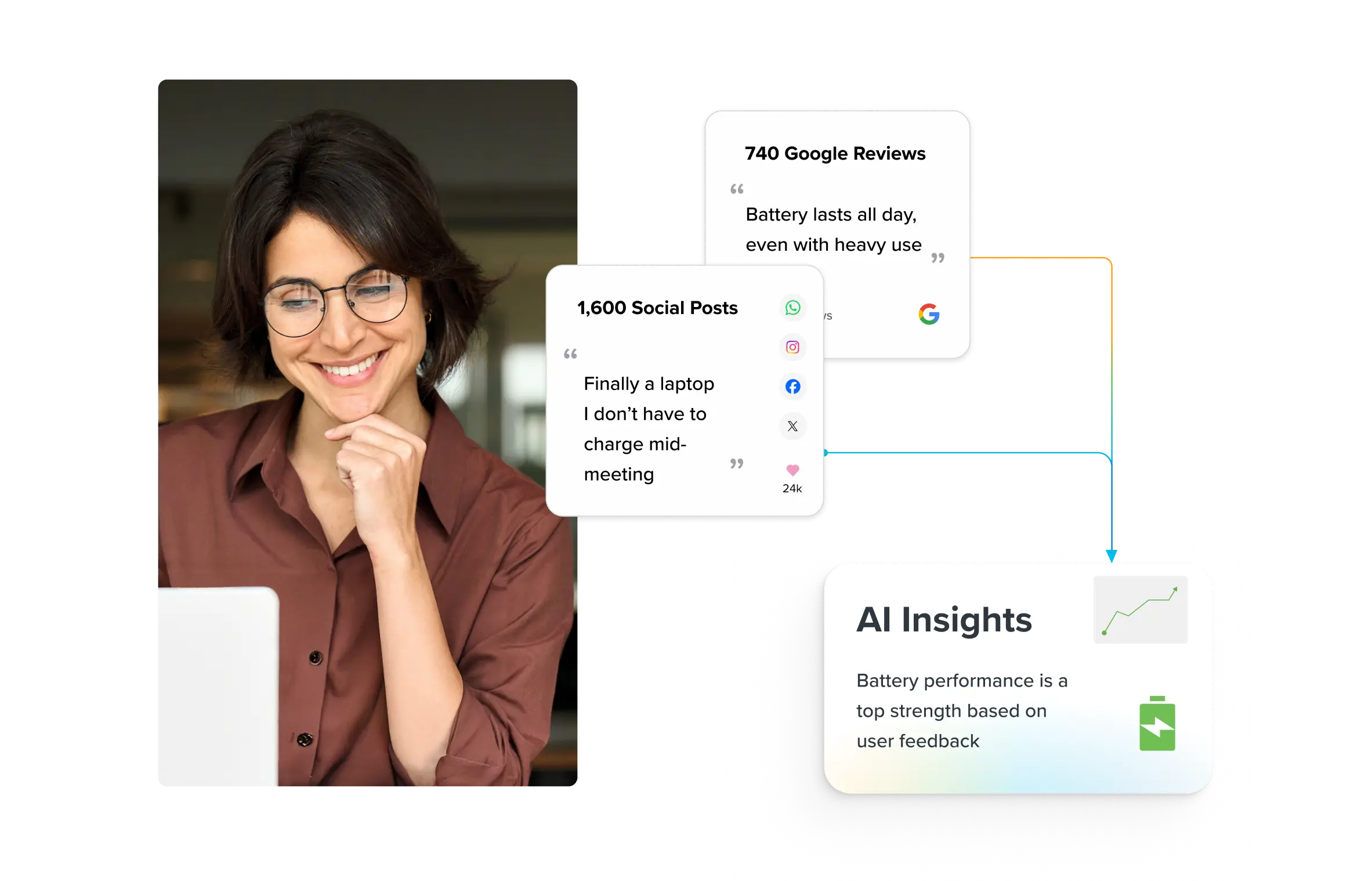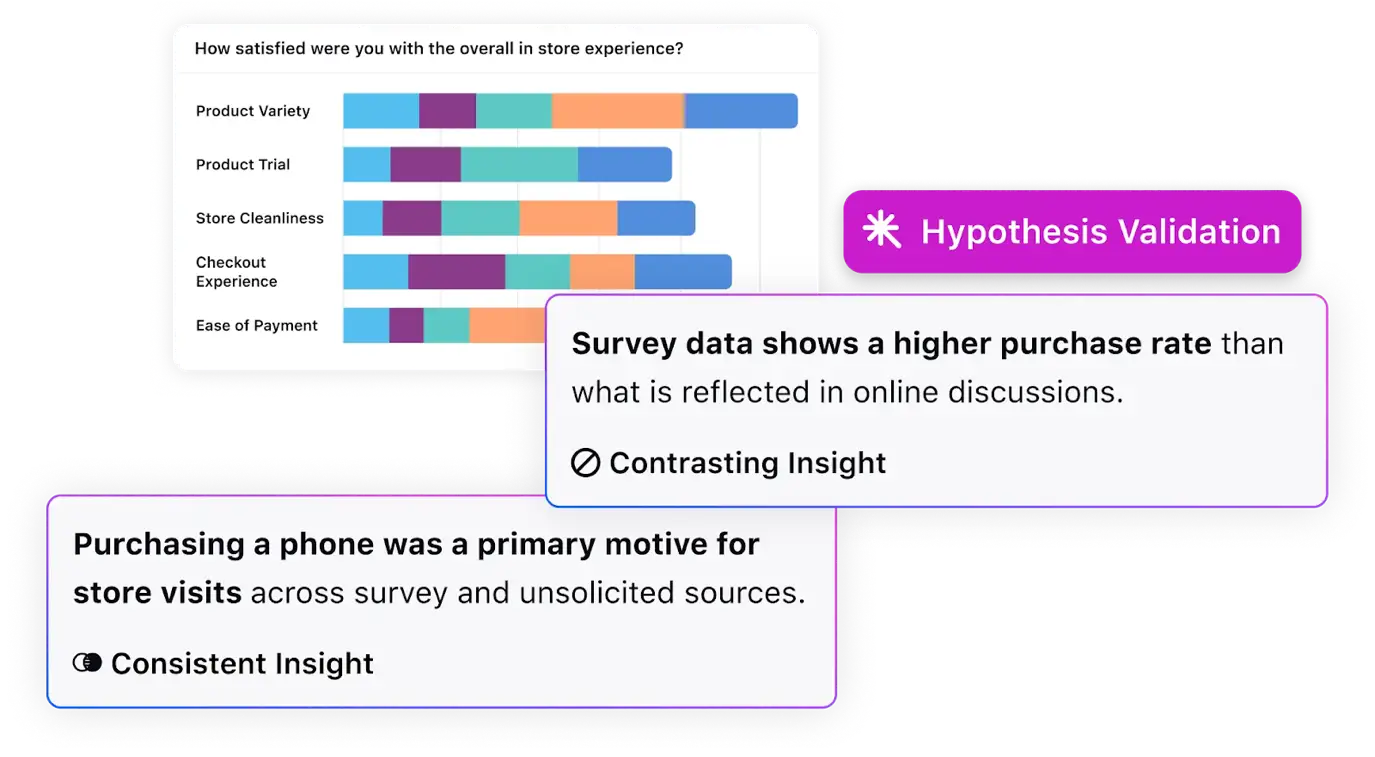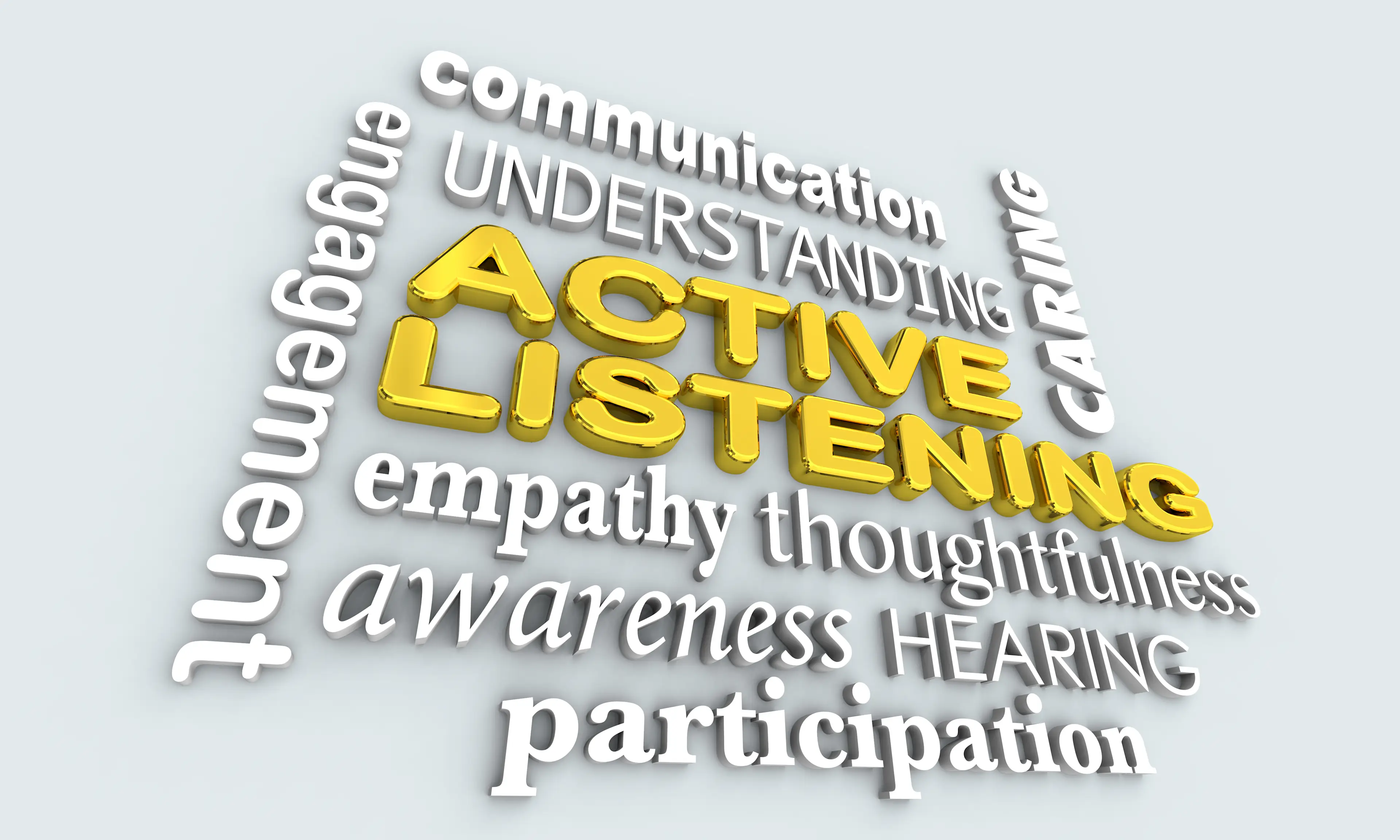Elevate CX with unified, enterprise-grade listening
Sprinklr Insights gives you real-time consumer, competitor and market intelligence from 30+ channels without the noise. Make smarter decisions, strengthen your brand, and stay relentlessly customer-led.

What is Customer Listening [+ 7 Actionable Insights]
The most customer-centric enterprises aren’t those that speak the loudest, they’re the ones that listen with the most precision. With advanced AI-powered platforms designed to capture not just what customers say, but why they say it, companies gain a competitive edge over other players.
Effective customer listening empowers CX, marketing, and digital teams to detect risks early, uncover unmet needs, and make informed decisions in real-time. 61% of online shoppers are more likely to buy from a brand if they’ve seen it recommended on social media. In this blog, you’ll learn why customer listening is more than just a CX trend, where teams often get stuck and how to fix it. You’ll also discover actionable strategies and future trends.
What is customer listening?
Customer listening is a strategic approach to understanding your target audience.
It goes beyond traditional surveys and transactional feedback by continuously capturing real-time insights from multiple customer touchpoints—social media, support chats, reviews, and more.
Unlike static feedback mechanisms, which provide a one-time snapshot of sentiment, customer listening offers continuous, dynamic insights into customer needs, preferences and pain points. It helps you understand not just what customers are saying, but why.
For example, Chick-fil-A’s social listening efforts revealed customer dissatisfaction when the Original BBQ sauce was replaced. By reintroducing the sauce in response to customer feedback, the company shifted sentiment from 73% negative to 92% positive, showcasing the power of active listening and responsiveness.
Good-to-know: This kind of agility is now enabled at scale. In 2025, Voice-of-Customer (VoC) programs, AI-powered listening tools and the shift to proactive CX are transforming how organizations listen to their customers. VoC programs collect and integrate feedback from all touchpoints, offering a comprehensive view of customer sentiment.
AI-powered tools process vast amounts of data from social media, online reviews and customer service interactions to identify patterns. The move toward proactive CX allows businesses to act on these insights, addressing needs before they escalate.
By proactively addressing customer needs, businesses can prevent customer churn, strengthen loyalty, and stay ahead of market shifts. Effective customer listening doesn’t just improve CX—it fuels long-term growth and builds a more resilient brand.
Also Read: 10 Best Social Listening Tools in 2025 (Features & Pricing)
The business impact of enterprise-level customer listening
At scale, customer listening moves from reactive surveys to real-time intelligence. From product roadmaps to GTM strategy, listening becomes a lever for reducing risk, accelerating innovation, and delivering better outcomes.
Here’s what that looks like when it’s embedded across the business:
1. Less noise, more strategic clarity
Most enterprises aren’t short on customer data—they’re overwhelmed by it. Feedback pours in from CRM systems, social media, surveys, contact centers, and product reviews, often in silos.
The result?
Conflicting signals, delayed action, and lost opportunities.
Modern customer listening platforms bring this data together, applying AI to identify what really matters. Are complaints spiking after a product launch? Where do users drop off during onboarding? Instead of reacting to the loudest voice, you gain strategic clarity—prioritizing what to fix, where to invest, and how to move faster.
Business payoff: Faster decisions, less internal friction, clearer visibility into where you’re earning or losing customer trust
2. Proactive CX that prevents churn
Waiting for survey results or support tickets to flag issues is too late. With AI-powered listening, you can detect frustration early and fix it before it impacts loyalty. Think immediate signals from social media, chat logs or community forums that surface pain points within hours, not weeks, after they appear.
Business payoff: Lower churn, higher CSAT, fewer escalations.
Starbucks actively monitors social media platforms to identify and address customer concerns promptly. For instance, the company has responded to feedback about long wait times at certain stores by engaging directly with online customers, apologizing for the inconvenience and requesting additional details to resolve the issue.
3. Product innovation that reflects market reality
In enterprise environments, the cost of building the wrong feature is more than just wasted time. It can mean lost market share, customer trust, and internal momentum. Customer listening mitigates this risk by grounding roadmaps in actual user behavior and feedback.
Whether it’s identifying recurring usability friction in international markets or identifying features customers want but don’t fully understand, customer listening closes the gap between roadmap and reality. And when you launch with confidence, you iterate faster, de-risk more and outperform competitors stuck in slower cycles.
Business payoff: Higher adoption rates, fewer feature failures, faster innovation cycles.
Fitbit effectively utilized social listening to enhance user engagement through its “Reminders to Move” feature. By monitoring user feedback and conversations, Fitbit identified a common challenge: users often became sedentary during work hours.
In response, they introduced hourly reminders prompting users to take a brief walk, significantly boosting daily activity levels. This feature led to a notable increase in user engagement and satisfaction, demonstrating the power of integrating customer insights into product development.
4. Messaging that cuts through
Even the best creative won’t land if it’s built on assumptions. Customer listening empowers marketing teams with live insight into what audiences care about, what language resonates and how customer sentiment shifts in response to market or brand events. This approach ensures that your campaigns are grounded in real customer experiences, enhancing relevance and impact.
Business payoff: More effective campaigns, faster go-to-market optimization, stronger brand equity.
McDonald’s effectively utilized social listening to enhance its marketing strategy during the “Grimace’s Birthday” campaign. When a viral TikTok trend emerged around the Grimace shake, the brand quickly engaged with the trend through humorous memes, boosting engagement and generating free marketing.

This proactive approach contributed to strong Q2 earnings, demonstrating how live social listening can inform and amplify marketing efforts.
5. Cross-functional alignment on customer truth
Often teams in large enterprises work in silos and operate with fragmented insights. This leads to inconsistent actions, duplicated efforts, and priorities that fail to reflect the full customer picture.
Customer listening solves this by centralizing insights and making them accessible across departments, not just in siloed dashboards but in workflows. So, the product team knows what support is hearing, CX knows what marketing is promising and strategy teams see what’s driving sentiment shifts in new markets.
Business payoff: Increased organizational agility, reduced duplication of effort, tighter execution around customer needs.
When done right, listening to customers becomes a strategic asset. It helps you move faster, reduce risk and stay aligned with what your customers truly need.
How to listen to your customers: build a customer listening strategy
If you’re committed to customer-centricity, you need a system that is scalable, detects patterns early and feeds directly into decision-making. Here’s how to build a customer listening practice that drives meaningful change across your business.
Step 1: Audience identification and segmentation
Customer listening only drives impact when it's focused on the right people. Without clear audience segmentation, even the most advanced tools can generate more noise than insight.
Strategic segmentation ensures your listening efforts align with business goals—whether you're targeting high-value customers, identifying churn risks, or optimizing customer journeys. It also creates a shared understanding across teams, from product to marketing to CX.
How to do it:
- Start with audience identification: Analyze customer journeys, transaction histories, channel usage and demographic data to pinpoint who your key audiences are. Use sources like CRM systems, web analytics, customer service logs and sales data to define meaningful cohorts.
- Use data-driven segmentation: Leverage first-party data and behavioral signals to create actionable audience clusters: high-value customers, at-risk accounts, power users, silent loyalists, etc. Tools like Sprinklr Insights can help map these segments and track sentiment.
- Forecast behavior shifts: Leverage machine learning to detect early churn signals or sentiment shifts within each segment, turning insight from reactive to predictive.
- Unify feedback across channels: Pull in input from social media, surveys, reviews, support tickets and more to build a unified profile of each segment. This gives you a full-spectrum view of preferences, pain points and evolving needs.
Best practice: Regularly revisit your audience segments (ideally quarterly) to ensure they evolve with changing customer behaviors.
Helpful Resource: Social Media Monitoring: The Complete Guide for 2025
Step 2: Creating a seamless feedback loop
Capturing feedback is only the start; real impact comes when it’s actioned. A robust listening strategy connects feedback with business decisions, turning customer insights into actionable strategies across departments.
How to do it:
- Centralize feedback across touchpoints: Integrate data from social media, customer support, surveys, reviews and more into a single platform. Sprinklr Insights uses AI to analyze unstructured feedback at scale, surface emerging themes and uncover sentiment trends. This gives you visibility into what matters most to each audience segment.
- Establish ownership: Route feedback to the right teams, e.g., product issues to engineering and service feedback to CX.
- Automate insight delivery: Enterprises are integrating listening tools with workflow platforms like Jira, Salesforce, or Slack using APIs or automation tools like Workato or Zapier to act quickly on customer insights. This allows feedback from sources such as support tickets, social sentiment, or surveys to be automatically categorized, tagged, and routed to the right teams. It creates a real-time feedback loop that turns listening into operational impact.
Best practice: Always close the feedback loop. Not just internally but also with customers. Let them know when their input leads to action.
Step 3: Leveraging technology for unified insights
AI and analytics are essential for turning feedback into actionable insights. The right platform consolidates all customer data, enabling your team to track sentiment on demand and act swiftly on insights.
How to do it:
- Unify listening across channels: Consolidate structured and unstructured feedback from all customer touchpoints into a single source of truth. Sprinklr Insights does this automatically, from social listening to support chats, enabling you to uncover root causes, track mood shifts and detect patterns early.
- Enable predictive insights with AI: Use predictive analytics in customer service to spot emerging trends and stay ahead of customer needs.
- Automate insights flow: Set up automated alerts to ensure teams receive insights live, helping them stay agile.
Best practice: Regularly evaluate your technology stack to ensure it keeps pace with new channels and customer demands.
When you build a strong customer listening strategy, you gain the clarity and agility to act on what matters most. It’s how you stay ahead of expectations and the competition.
7 actionable insights from customer listening data
These seven insights will help you turn feedback into actions that improve customer experience, boost efficiency and support your business goals.
1. Leverage real-time analytics for proactive service
Capturing real-time data is key to identifying emerging trends, enabling quick responses before a social media crisis escalates or to support timely, in-the-moment marketing. By monitoring real-time data from sources like social media, live chat or support tickets, you can identify potential issues early. It helps you increase customer satisfaction by proactively addressing issues.
Impact: Earlier identification of pain points leads to lower churn, stronger customer loyalty and a more responsive brand experience.
2. Integrate multi-channel listening platforms for a holistic view
Consolidating data from diverse sources (social media, call centers, surveys, etc.) enables a comprehensive understanding of customer sentiment. By integrating these channels, you create a unified view of the customer experience, which helps prioritize issues and streamline responses.
Vi utilized Sprinklr’s Unified-CXM platform to unify customer feedback from over 450 retail stores and 2,000 small stores. This integration led to a 500% increase in Google reviews and a 40% rise in positive reviews for physical stores, demonstrating the impact of a consolidated customer feedback system.
Impact: Faster, more accurate decision-making and a complete picture of the customer journey.
3. Empower frontline teams with active listening training
Frontline teams are in the best position to capture customer insights, but they need the right tools and training to do so effectively. Active listening training enables support staff to pick up on subtle cues, identify pain points and escalate issues appropriately.
Impact: Enhanced problem-solving at the first point of contact, leading to quicker resolution times and improved customer satisfaction.
Bonus Read: Active Listening in Customer Service: 6 Ways to Implement It
4. Utilize market segmentation for targeted messaging
Segmenting your audience based on feedback helps personalize your messaging and offers. By understanding the unique needs of each customer segment, you can tailor your outreach to specific preferences, increasing engagement and conversions.
L'Oréal employed advanced behavioral and psychographic segmentation to better connect with younger demographics. Recognizing that traditional age-based segmentation was insufficient, the brand collaborated with Google and McCann to create 12 distinct ad variations targeting specific interests and behaviors within Gen-Z and Millennial groups.
Impact: Increased engagement, personalized customer experiences and higher conversion rates.
5. Build a robust feedback loop for continuous improvement
An effective feedback loop ensures that customer insights lead to actionable changes. Integrating insights into operational processes, product updates and customer service improvements allows you to evolve continuously and meet customer expectations.
You can use feedback to inform product development, customer service strategies and process optimizations. Ensure that insights are actively fed back into the business through regular team reviews and decision-making forums.
Impact: Continuous improvements in product quality, service delivery and faster response to changing customer needs.
6. Measure customer satisfaction to refine approaches
Tracking customer satisfaction metrics (like NPS, CES and CSAT) provides a measurable way to gauge the effectiveness of your strategies. Regularly analyzing these metrics helps identify areas for improvement and fine-tune customer engagement strategies.
Regularly track and analyze satisfaction scores through surveys and post-interaction feedback. Moreover, use AI-powered customer analytics to identify trends and pinpoint areas where customers feel underserved.
Sprinklr has revolutionized customer feedback management by introducing AI-first surveys powered by its Unified-CXM platform. These surveys enhance response rates, yield higher quality responses and significantly reduce the time to insights. By leveraging AI, you can promptly identify areas for improvement, leading to more informed decisions and refined customer engagement strategies.

Impact: Enhanced customer loyalty, reduced churn and more informed decisions based on real-time feedback.
7. Align insights with strategic objectives
You should integrate customer insights into business strategies to drive long-term growth. By aligning feedback with broader organizational goals, you ensure that customer needs are being met in ways that also contribute to your company’s overall mission.
You can create a framework that links customer feedback with strategic initiatives. Plus, regularly align customer insights with KPIs and business outcomes to ensure your customer experience goals are directly tied to your overall business success.
Impact: Stronger alignment between customer expectations and business objectives, leading to sustainable growth.
Leveraging these insights enables personalized experiences, drives operational improvements and keeps you ahead of customer expectations for long-term success.
Future trends in customer listening
As customer expectations evolve and data volumes grow, the future of consumer listening lies in scaling intelligence without losing nuance. Modern organizations are shifting from passive feedback collection to active, predictive intelligence that informs decisions across the business.
Here’s what’s shaping the future:
1. AI-led voice and text analysis
Natural Language Processing (NLP) in social media and text analysis are transforming unstructured data like comments, chats, and reviews into real-time actionable insights. By analyzing language patterns, tone, and context, NLP detects sentiment shifts, emotional cues, and intent. Voice and text sentiment analysis tools go beyond traditional surveys, capturing the 'why' behind customer behavior. This enables brands to respond with greater empathy, relevance, and speed. As a result, businesses gain a richer, more proactive understanding of customer experience.
2. Omnichannel sentiment, tracked in real-time
The next generation of listening integrates social, support, messaging apps, communities and in-app behavior into a unified stream of sentiment data. It allows for faster, coordinated responses and trend detection before a crisis hits.
3. Privacy-conscious listening at scale
As privacy regulations like GDPR and CPRA become more stringent, enterprises must find smarter ways to understand their customers without risking data breaches or non-compliance. By relying on tools that prioritize first-party data (collected directly from users) and zero-party data (information users intentionally share), organizations can gather high-quality insights while staying within legal boundaries. This approach not only supports compliance but also builds long-term trust with customers at scale.
4. CX meets EX: Listening across the customer–employee loop
Forward-looking organizations are connecting customer feedback with employee sentiment, identifying correlations between frontline experience and customer satisfaction. Unified EX + CX analytics will drive internal alignment and surface friction across both journeys.
As customer expectations evolve, staying ahead with AI-driven insights, omnichannel tracking and privacy-conscious strategies will be key. Embrace these trends to continuously enhance your customer listening strategy and drive meaningful business outcomes.

Amplify business impact with effective customer listening
When you build a listening strategy that starts with clear audience segmentation, integrates multi-channel feedback and delivers unified, immediate insights, you’re not just hearing your customers but also understanding them at scale.
The result? Faster, more aligned decisions. Proactive issue resolution. Stronger customer relationships. And ultimately, measurable impact on growth, retention and brand trust.
Sprinklr Insights helps you operationalize this vision. With AI-powered sentiment analysis, real-time omnichannel monitoring and customizable dashboards that unify voice, text, social and survey data, it turns noise into signals and signals into strategic actions.
Ready to see what deep customer listening looks like in action?
Frequently Asked Questions
Customer listening improves customer satisfaction by gathering feedback across channels like email, chat, and social media. This allows teams to identify common issues, personalize customer experiences, and resolve problems faster
Yes, customer listening helps detect early signs of dissatisfaction, such as delays in support response or negative sentiment in feedback. By acting on this data early, customer success teams can improve retention among key accounts.
AI analyzes large volumes of unstructured data (like social posts, reviews and support tickets) to surface trends, sentiment and intent faster and with greater accuracy.
Companies should track KPIs like customer satisfaction score (CSAT), net promoter score (NPS), and customer effort score (CES). Internal metrics such as ticket resolution time and product improvement cycles also indicate success.
Unlike traditional feedback methods that rely on scheduled prompts, customer listening continuously gathers feedback from organic customer interactions. This gives enterprise teams a holistic view of the customer experience and surfaces issues that often go undetected through formal feedback loops.









